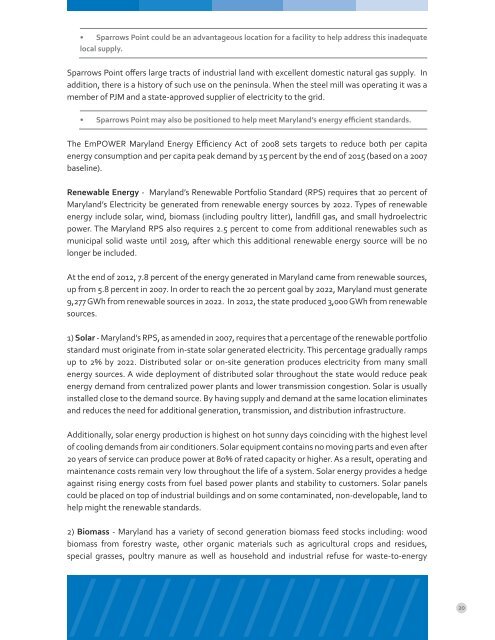COMMON GROUND
You also want an ePaper? Increase the reach of your titles
YUMPU automatically turns print PDFs into web optimized ePapers that Google loves.
• Sparrows Point could be an advantageous location for a facility to help address this inadequate<br />
local supply.<br />
Sparrows Point offers large tracts of industrial land with excellent domestic natural gas supply. In<br />
addition, there is a history of such use on the peninsula. When the steel mill was operating it was a<br />
member of PJM and a state-approved supplier of electricity to the grid.<br />
• Sparrows Point may also be positioned to help meet Maryland’s energy efficient standards.<br />
The EmPOWER Maryland Energy Efficiency Act of 2008 sets targets to reduce both per capita<br />
energy consumption and per capita peak demand by 15 percent by the end of 2015 (based on a 2007<br />
baseline).<br />
Renewable Energy - Maryland’s Renewable Portfolio Standard (RPS) requires that 20 percent of<br />
Maryland’s Electricity be generated from renewable energy sources by 2022. Types of renewable<br />
energy include solar, wind, biomass (including poultry litter), landfill gas, and small hydroelectric<br />
power. The Maryland RPS also requires 2.5 percent to come from additional renewables such as<br />
municipal solid waste until 2019, after which this additional renewable energy source will be no<br />
longer be included.<br />
At the end of 2012, 7.8 percent of the energy generated in Maryland came from renewable sources,<br />
up from 5.8 percent in 2007. In order to reach the 20 percent goal by 2022, Maryland must generate<br />
9,277 GWh from renewable sources in 2022. In 2012, the state produced 3,000 GWh from renewable<br />
sources.<br />
1) Solar - Maryland’s RPS, as amended in 2007, requires that a percentage of the renewable portfolio<br />
standard must originate from in-state solar generated electricity. This percentage gradually ramps<br />
up to 2% by 2022. Distributed solar or on-site generation produces electricity from many small<br />
energy sources. A wide deployment of distributed solar throughout the state would reduce peak<br />
energy demand from centralized power plants and lower transmission congestion. Solar is usually<br />
installed close to the demand source. By having supply and demand at the same location eliminates<br />
and reduces the need for additional generation, transmission, and distribution infrastructure.<br />
Additionally, solar energy production is highest on hot sunny days coinciding with the highest level<br />
of cooling demands from air conditioners. Solar equipment contains no moving parts and even after<br />
20 years of service can produce power at 80% of rated capacity or higher. As a result, operating and<br />
maintenance costs remain very low throughout the life of a system. Solar energy provides a hedge<br />
against rising energy costs from fuel based power plants and stability to customers. Solar panels<br />
could be placed on top of industrial buildings and on some contaminated, non-developable, land to<br />
help might the renewable standards.<br />
2) Biomass - Maryland has a variety of second generation biomass feed stocks including: wood<br />
biomass from forestry waste, other organic materials such as agricultural crops and residues,<br />
special grasses, poultry manure as well as household and industrial refuse for waste-to-energy<br />
//////////////<br />
20



